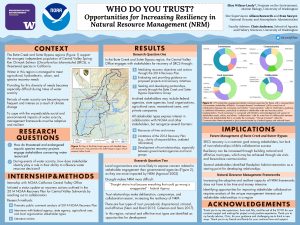WHO DO YOU TRUST?: OPPORTUNITIES FOR INCREASING RESILIENCY IN NATURAL RESOURCE MANAGEMENT
As climate change increases the frequency and intensity of climatic conditions worldwide, natural resource management (NRM) frameworks must be prepared to adapt and mitigate the impacts on human and natural systems. However, there is not a “one size fits all” solution; resilient NRM institutions must be tailored to the unique biophysical, social, cultural, and economic contexts of specific regions. The purpose of this study was to explore the social context that influences stakeholder engagement with water resource management and species recovery in the Butte Creek and Sutter Bypass regions in the California Central Valley. To achieve this, I conducted a public comment analysis of the 2014 NOAA Draft Recovery Plan for Central Valley Salmonids, stakeholder interviews, and a literature review. Additionally, my internship with National Oceanic and Atmospheric Administration (NOAA) supplemented my perception of the social context between stakeholder groups, as I had the opportunity to experience and engage in natural conversations with NOAA staff and stakeholders. NRM theory states that institutions can increase resiliency through increasing trust diversity. In the Butte Creek and Sutter Bypass regions, increased resiliency can be achieved through the development of rational and affinitive trust types. A key component to increasing trust diversity in a management framework is through identifying, acknowledging, and incorporating diverse stakeholder perspectives into management. Therefore, my research demonstrates that focusing on the unique contexts of NRM frameworks is essential to identifying opportunities for increasing resiliency within local management contexts and also in the face of climate change.
